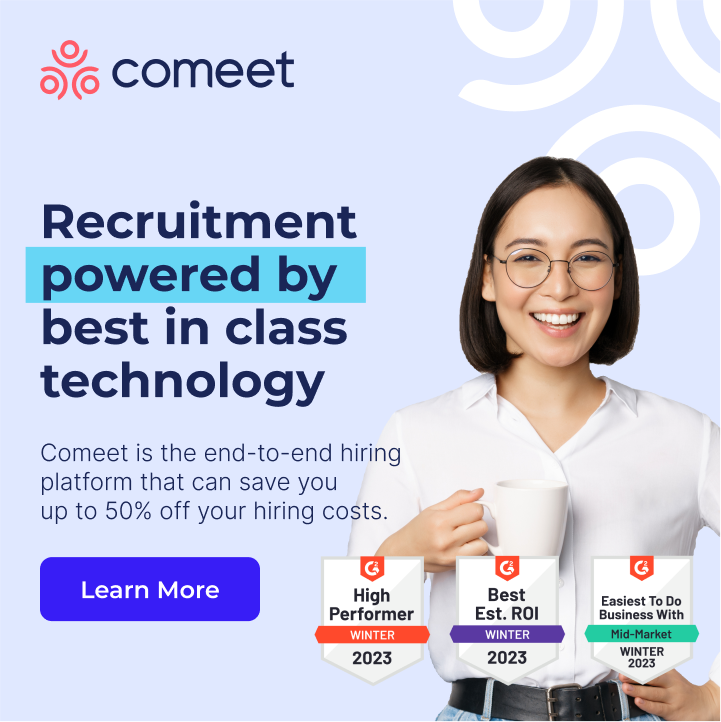Job fairs can expose new candidates to your company in ways printed ads can’t. Are they worth the cost? How can you maximize their results? Learn the basics of this traditional hiring tool to find out if it’s for you.
Before Participating in a Job Fair
Weeks and months before the date of the job fair, you should have some items completed. They include:
1. Create Recruitment Goals
The only way to know if the job fair is a success is to set goals to meet—or, hopefully, exceed. They may center around objectives such as:
- The type of candidate you want to recruit
- The open positions you need filled
- Career or technical skills you hope to utilize
You can then set out to plan for the job fair that will meet these goals. Entry-level positions, for example, may be best filled through college job fairs or career days at learning communities. Industry-specific job fairs can put you in touch with role- or skill-specific candidates.
2. Put Your Players in Place
Not everyone is best-suited to be the face of your company at a job fair. Human resources staff is a natural fit for the task since that’s what they do every day. In addition to bringing along hiring pros, get some additional support from others involved in the hiring process, especially if a manager or team leader will have say in the final decision. It also doesn’t hurt to have a few other employees on hand to answer specific questions about culture, benefits, and overall job satisfaction.
Prepare for the Job Fair
Now you’re ready to contact the event organizers and get your spot at the fair. This may include paying a fee and giving the event team some digital assets, such as your logo, to help them with advertising. You’ll also want to take the following actions to get ready:
1. Order Marketing Materials
This will usually include business cards to hand out with the recruiter’s contact information, as well as name tags for team members. You may also choose to include brochures. Some companies have digitized these items by including, say, QR codes on business cards that candidates can scan to access a custom website with more information.
Whether you include promotional giveaway items is up to you. However, be sure to make it something affordable that represents your company culture, makes a strong first impression, and won’t just end up in the trash.
2. Create a List of Questions to Ask
Get to know your potential candidates and further encourage those that may be a good fit to take the next steps to apply:
- What is your experience with this skillset or software?
- How have you used this knowledge in your past work or education?
- What interests you most about this industry?
- If you could learn anything about X, what would it be?
- What interested you in our business?
- Which part of working for us seems the most exciting?
3. Promote the Event
Whether you buy ads on social media or in newspapers is up to you. Some businesses have done well by using word-of-mouth and organic social media methods to promote the career fair. Make sure your employees know, too, because they provide a more authentic method of sharing than any advertisement could.
Don’t forget to advertise on community bulletin boards where likely candidates may see it. For example, many colleges have a board for these announcements that they will happily let you use.
During the Job Fair
The event is here and you’ve done your preparation. Follow these best practices to ensure success:
1. Arrive Early
Even if you were able to set up your table the night before, there’s still some prep work to do. It’s essential to double-check that you have access to electricity and Wi-Fi. Get your people in place before the event starts so that the first attendees know you’re ready to greet them.
2. Engage with Everyone
Not all interested candidates will be assertive, so be sure to make eye contact with as many people as possible and take steps to talk to those who don’t approach you first. At the same time, avoid talking too long to any one person—there are many people to socialize with. Limit your interactions to only what is needed to get a feel for a candidate and refer them to the next step in the process.
3. Use Creative Tactics to Attract Visitors
Get more people to learn about your employment opportunities by offering giveaways and promotions that create buzz and reward engaged visitors. It’s best if you fulfill prizes at the event, rather than wait until afterward. This keeps your momentum going and makes sure your giveaway is credible.
4. Get Candidate Details and Offer Next Steps
Ask for resumes and CVS for the next step in reaching out. If you redirect inquiries to a custom website, include directions for how they can let you know that learned about you at the job fair. A promo code or specific URL short-link will do this easily.
Don’t forget to tell them what they can expect when they apply. When will they hear back? What can they do in the meantime? Don’t make them feel insignificant or leave them wondering if they fell through the cracks. Use your applicant tracking system to help with this step.
After the Job Fair
The job fair may be over, but now the real work begins. Don’t skip any of these essential steps in following up and moving forward with your full life cycle recruiting process.
1. Get in Touch with Candidates
This is where many HR departments mess up. Job seekers leave these events eager for the next steps, so be sure they know what to expect. Contact the best ones right away while they still remember you and what they found interesting about the position. If they haven’t already applied:
- Ask them to fill out an application
- Schedule a screening call
- Schedule in-person interviews with the best candidates
For the most part, you’ll handle their recruitment in the same way you would any applicant, but with a focus on timeliness. You don’t know how many other companies they chatted with at the career fair, so act fast to avoid missing out on the best people.
2. Collect and Summarize Data
You’ll also want to see how effective your job fair was in getting new recruits. While you may feel good about how it went overall, the hard data will back up those good feelings with measurable results you can use to justify adding a future event to your recruitment budget.
- Number of attendees you made contact with at the event
- Number of applicants you received
- Number of interviews you scheduled
- Number of total qualified candidates in the applicant pool
- Overall time to hire compared to traditional methods
Data is just one thing to consider. If you found even one qualified hire that you wouldn’t have found elsewhere, a job fair may be worth revisiting every now and again to keep your applicant pool fresh. It’s also an excellent way to get the word out about your brand.
Need help tracking all of the interested candidates you met at a job fair? Learn how Comeet makes it easy to keep tabs on applicants through every phase of the full life cycle recruiting process.





























